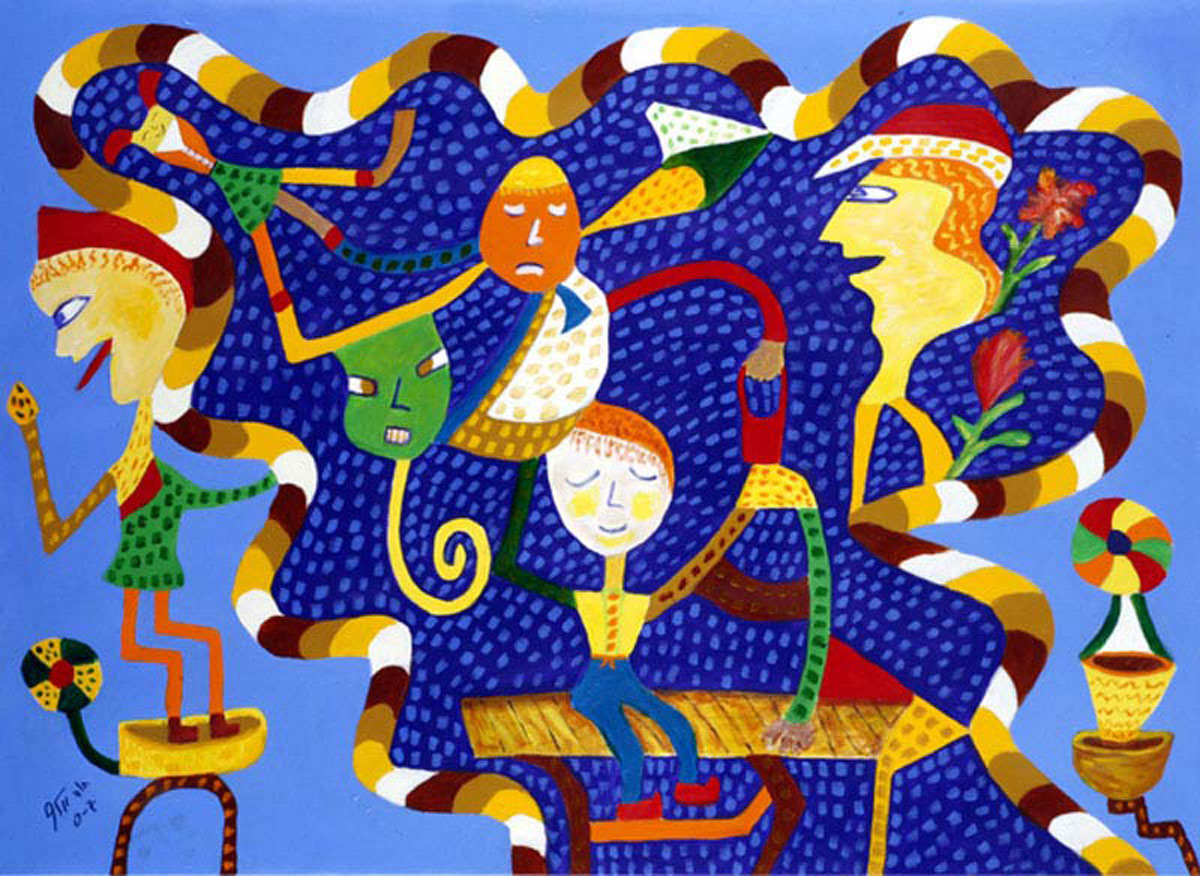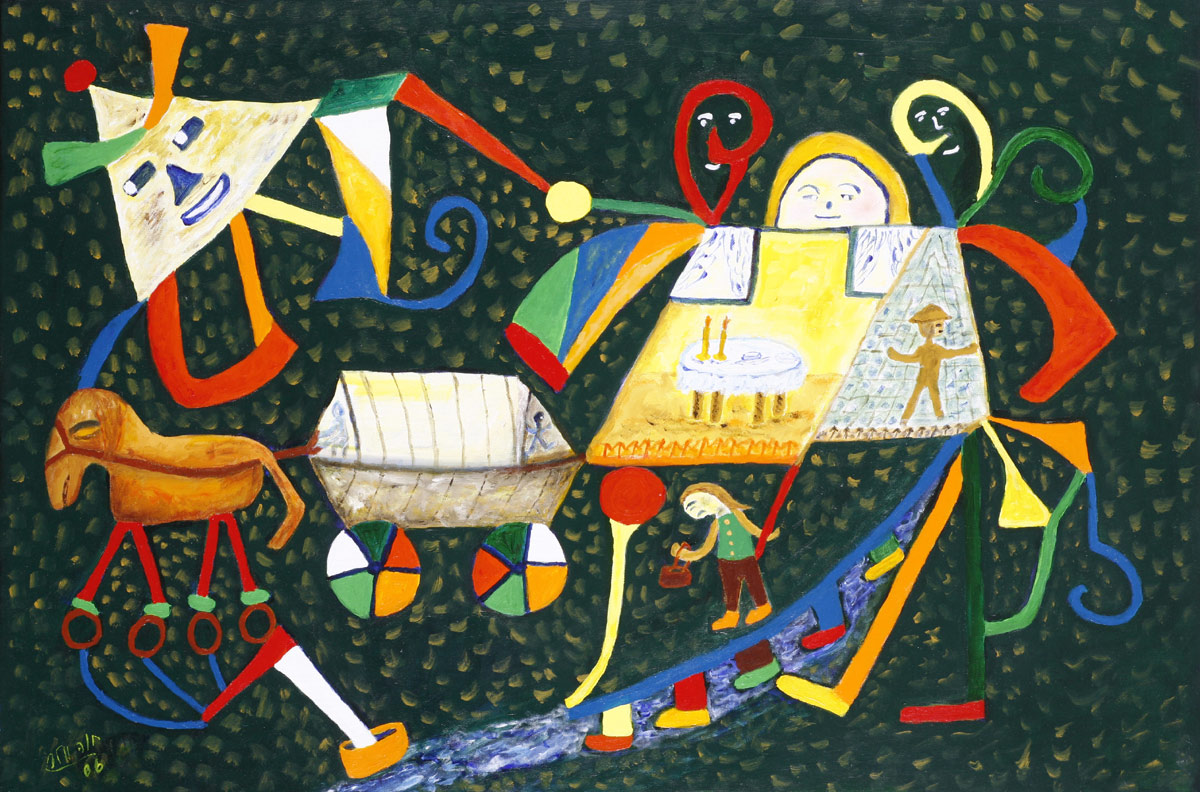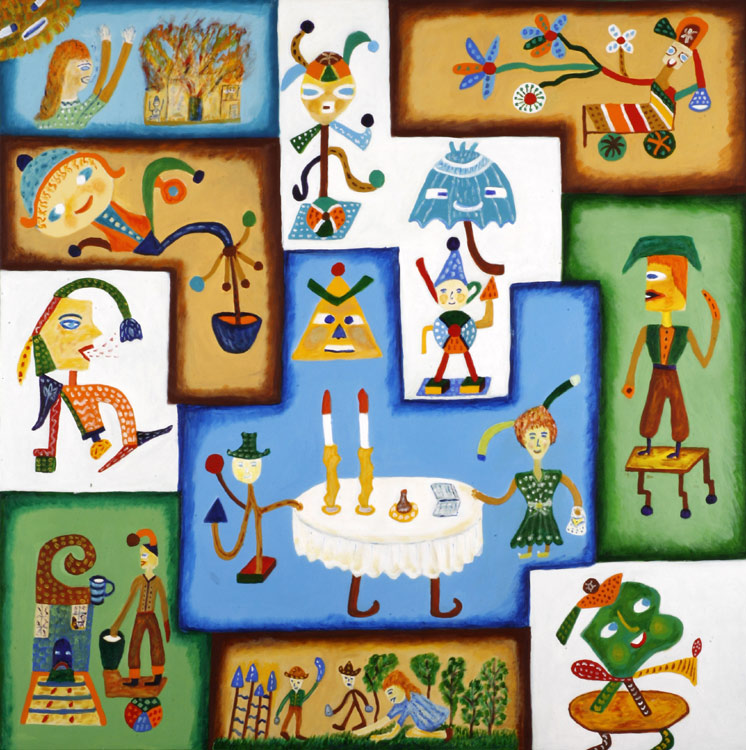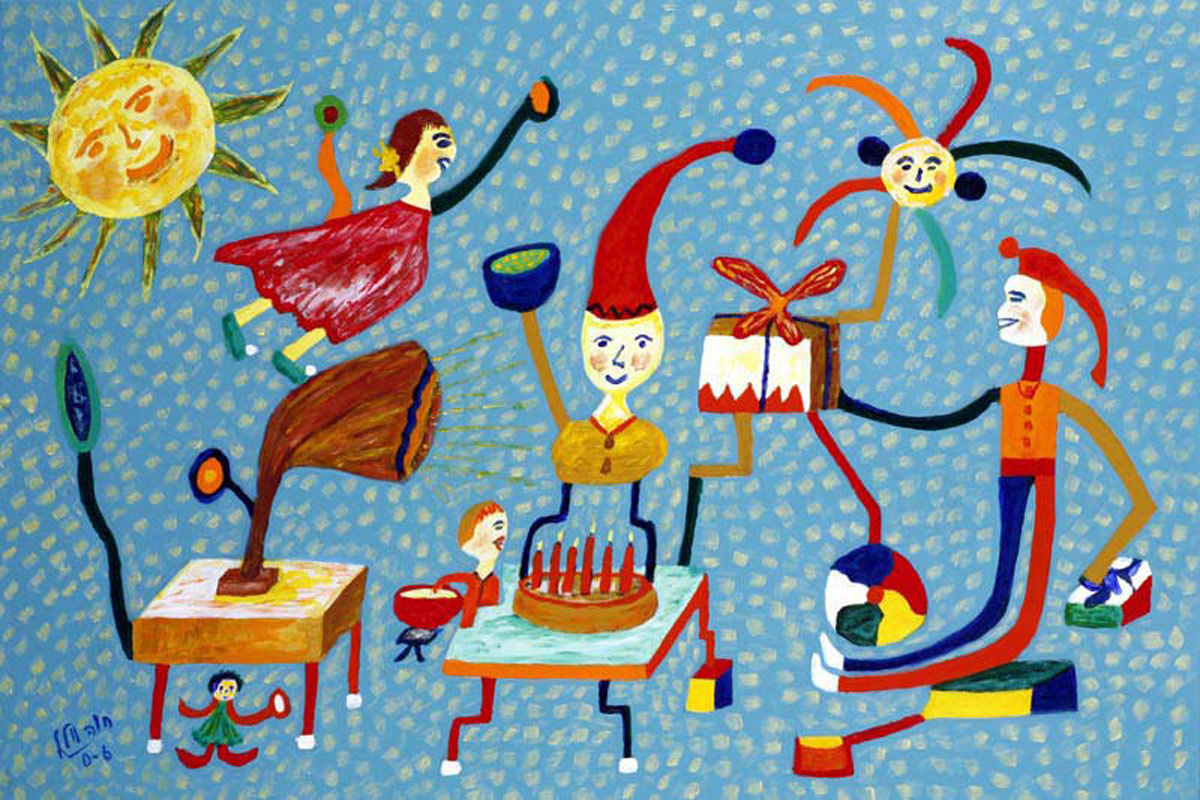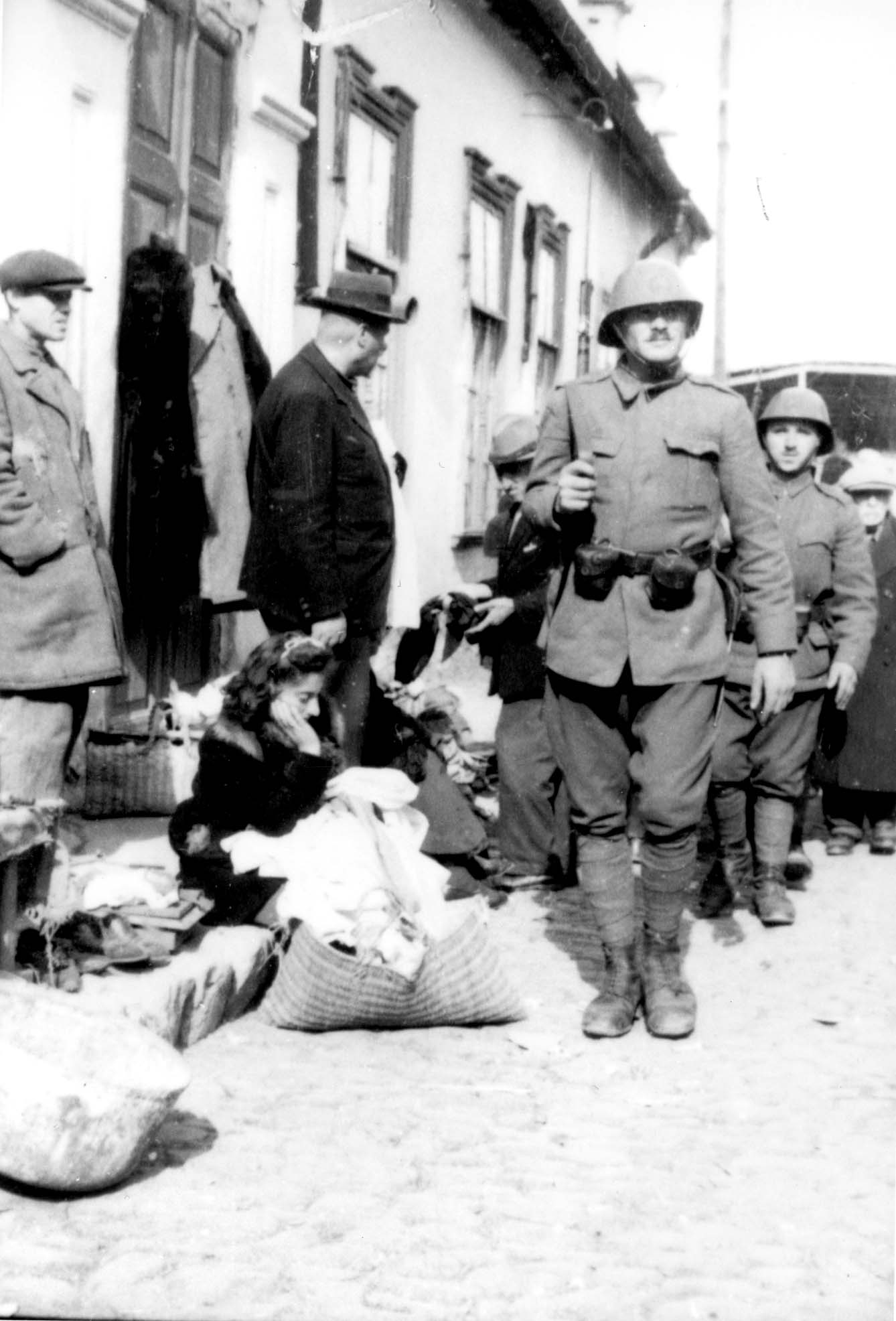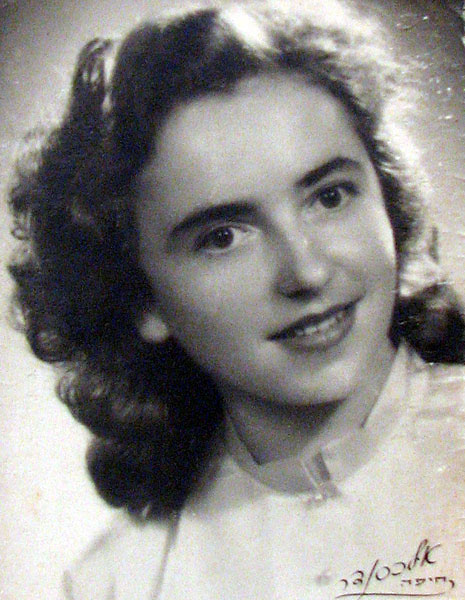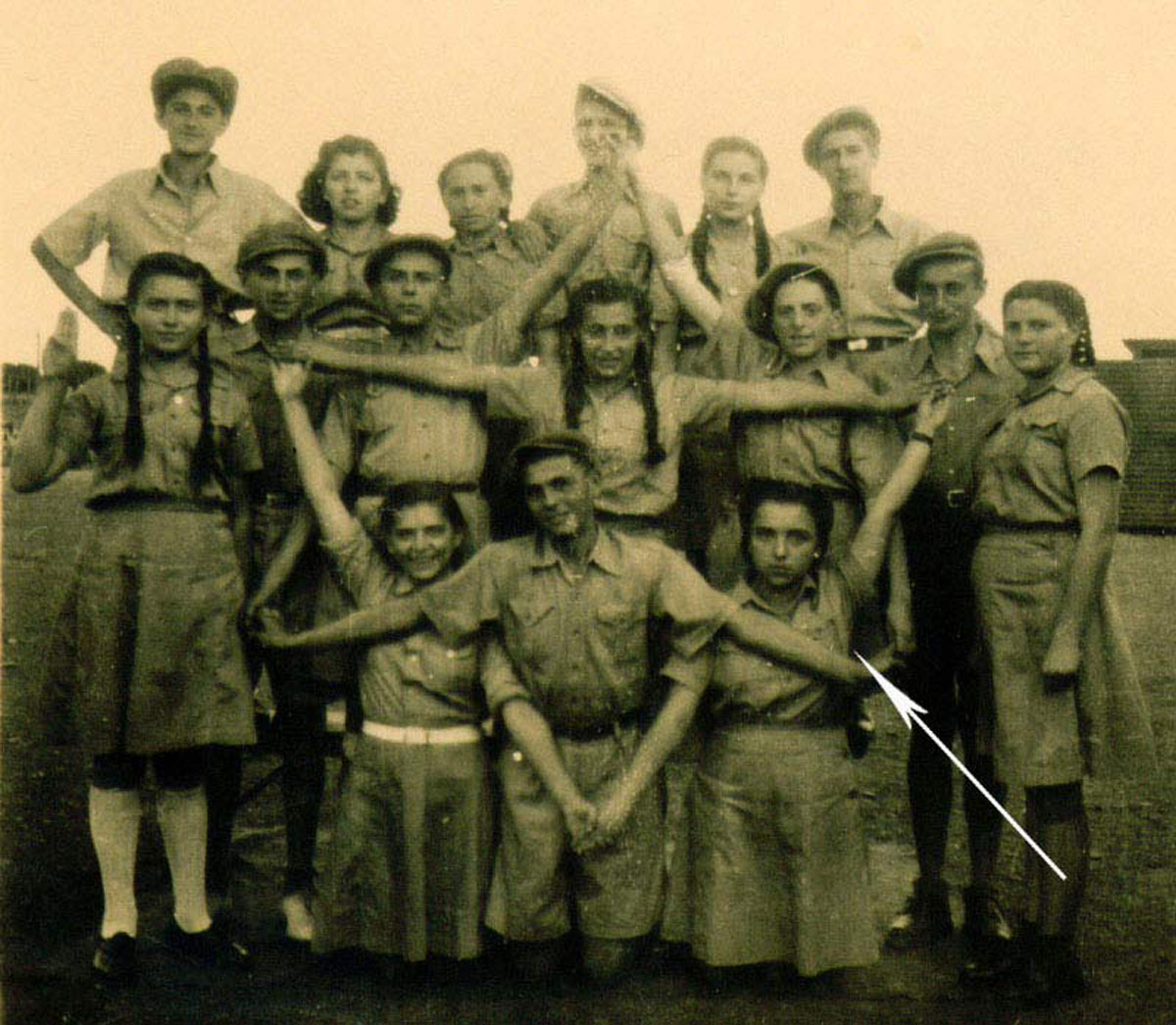Grades: 6 - 9 (with previous knowledge about the Holocaust)
Duration: 2 - 2.5 hours
- Jewish religious sect.
- Potentially fatal infectious disease.
- The diary of an unknown woman, Lodz Ghetto, From Naama Galil & Hadas Steuer (Eds.), “Walls All Around Us”: a study kit on the subject of ghettos, booklet 2 – Isolation and Detachment [Hebrew], The International School for Holocaust Studies. No year of publication.
- Yad Vashem Archive O.48/47.B.1. Avraham Koplowicz was born and lived in Lodz. He was murdered in Auschwitz-Birkenau in September 1944.
- From Eva (Hava) Lubova, There Are No Butterflies Here [Hebrew], Moreshet & Sifriyat Hapoalim, third ed. 1996.
- Hannele Davidson, from Itzhak B. Tatelbaum (Ed.), Through Our Eyes, Yad Vashem, Jerusalem 2004, p. 18.
- Ibid. p. 19.
- Ibid, ibid.
- Ibid., p.80.
- Ibid., p.53.
- Ibid., p.81.
- Ibid., p. 42.
Didactive Objectives
- Acquaint students with the story of Chava Wolf, who was a Jewish child during the Holocaust.
- Expose students to Chava Wolf’s brightly colored, childlike paintings.
- Allow students to contemplate the symbolism inherent in the paintings.
- Encourage the students to discuss the unexpected use of colors and symbols, which deviate from our preconceived notions of representing death, horror, loss and hopelessness.
- Give children and teachers a sense of confidence in their ability to connect and create through their own artwork.
Introduction
Educators often approach Holocaust study from a historical point of view, deepening their students’ knowledge and understanding through the use of survivor testimony, classroom discussions, films, books and other disciplines.
However, teachers may find that the world of art offers their students a richer and more accessible path to processing this difficult and complex subject matter. Artwork and poetry can be employed in the classrooms not only to teach students about the Holocaust, but also to enlighten and inspire them to create their own artwork.
In the first part of this lesson, the students will be introduced to the work and life story of artist and Holocaust survivor, Chava Wolf. They will discuss examples of her paintings and learn about her personal and highly unique use of color, symbolism and composition. They will also hear samples of Chava's poetry, focusing on her ordeal in Transnistria. Students who are not familiar with art–related terminology, (image, symbol, and theme) will gain understanding of how these concepts are used in approaching an artwork. In the second part of the lesson, students will try to use their own personal language of symbols, colors, forms and composition to design their own creations.
It is our hope that at the end of this lesson, students will have gained a feeling of confidence regarding their own voice in relating to and creating artwork.
Preparatory Materials
To prepare for the first part of the lesson, teachers should read the interview with Chava Wolf which appears in this edition of e-newsletter. This text will familiarize the teacher with Chava’s life story.
The teacher may consult this link, which contains an overview of the Holocaust in Transnistria, in order to place Chava’s story in its historical context in the classroom. In addition, historical and visual docomentation will be provided to contextualize the artwork and deepen the student’s knowledge. Chava’s paintings should be printed for the students to see, or projected on a screen in front of the class.
Suggested Materials
- A3 Paper - strong Bristol or water color paper preferable
- Water color paints
- Tempera paints
- Oil pastels
- Felt tips
- Torn pieces of colored tissue paper
- Pencils
- Glue (stick glue is often easier for students to use)
Lesson Procedure
- Discussion of Chava Wolf’s Artwork (45 min – 1 hour)
- Students Create Their Own Artwork (1-1.5 hours)
Teachers can begin by engaging the class in a discussion about how they visually perceive emotions. What colors do they associate with sadness, happiness, fear, hope?
How would the students visualize these emotions? Tears for sadness? Smiles for happiness? What colors do they think would be appropriate for a subject as tragic as the Holocaust?
Part One
Note to the Teacher:
Often children will associate sombre colors – blacks, greys, dark purples, dark blues and reds – with sadness and mourning. Happy colors are usually considered to be yellows, oranges, pinks, light blues, and light greens. Students can discuss why the Holocaust is often perceived in such dark tones, or in black and white. They can be reminded that although most of the visual information we have about the Holocaust comes from the black and white footage and photographs of the period, the Holocaust happened in the real world, the world of color, of winters and summers, of trees and butterflies.
The teacher will then introduce the students to the life story of Chava Wolf, an artist who survived the Holocaust in Transnistria, which they can find in the interview with her. At this point, students still have not seen any of Chava’s artwork.
Note to the Teacher:
Teachers can proceed to show the class the first of Chava's paintings - a picture of the crossing of the Dniester River. Above them is a train loaded with Jewish deportees, caught between two bizarre, large figures. These two menacing “evil men” - or “devils”, as Chava calls them - represent the Nazis and their helpers who overshadow and control everything. The scene happens against a background of rain, symbolizing the ceaseless rain Chava remembers from her time in the ghetto. Despite their childlike quality, the picture depicts a very difficult image – note the bodies floating in the river. This is a scene Chava had witnessed first-hand as a child.
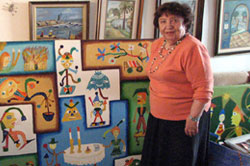
Chava Wolf-Wijnitzer with her artwork, 2009
Teachers may wish to conduct an open discussion with their students focusing on the list of questions below. Clearly there are no right or wrong answers. Over the course of the discussion, teachers will explain Chava’s own explanations (appearing in the notes to teachers), and this will help “unlock” much of her own symbolic language.
Questions:
- What do you see in the picture?
- What is happening in the river?
- Who are the figures with the orange hats and yellow faces?
- Who are the woman crying, who is the child next to the river?
- What is the strange vehicle in the picture?
- Who are the two large menacing figures? What do their facial expressions show? Their hands?
- Who might be the little girl on the left-hand side? Why doesn’t she have any arms or legs?
- Why did the grown up Chava choose to draw Nazis so colorfully, without their official uniforms? Why do they not look like real people?
Note to Teacher:
The photographs on the side depict actual historical photographs of Jews crossing the Dniester River, and of Rumanian soldiers in uniform. Comparisons can be made in the classroom between the actual documented events and characters, and Chava’s representation of them. Chava perceives these images as she did when she was a child. As a child she saw these Nazi soldiers and their collaborators as menacing “bad people”, and was less aware that these were soldiers. By portraying them as the strange figures we see here, she is expressing how cruel and inhuman she perceived them to be as a child. For Chava, it is less important to portray them realistically than it is to show her impression of them.
![Chava Wolf [describing the painting depicting the crossing from Ataki to Mogilev]: “They killed people in the river. These are the packed trains. The car is hung in thin air, not going to any destination.” Chava Wolf [describing the painting depicting the crossing from Ataki to Mogilev]: “They killed people in the river. These are the packed trains. The car is hung in thin air, not going to any destination.”](https://www.yadvashem.org/sites/default/files/wolf3b.jpg)
Chava Wolf [describing the painting depicting the crossing from Ataki to Mogilev]: “They killed people in the river. These are the packed trains. The car is hung in thin air, not going to any destination.”
Note to the Teacher:
While imprisoned in the ghetto, a Nazi soldier struck Chava on her head with the butt of his rifle, severely wounding her. The swelling and infection took a very long time to heal. Yet this child in the painting is smiling, gazing towards another place. Her arms have become wings expressing her desire to fly away. Chava’s feet are on wheels, a motif that appears throughout her artwork. She explained that this symbolizes how unsteady and unbalanced everything in this bizarre world had become to this child, who had once been surrounded by a warmth, love and stability. The frightening yellow figure with the distorted eyes is the SS man delivering the blow. Again in Chava’s childish representation, this soldier is a menacing, devil-like creature. This “Satan”, as Chava calls him, embodies all of the soldiers who were responsible for her beautiful childhood to disappear. In the closed and inaccessible house below her, we see two Shabbat candles, a symbol of the normalcy of the religious Jewish life that Chava led before the war, now closed to her forever. The bottles below possibly represent water, which was scarce in the ghetto. Chava once witnessed the execution of a thirsty child who had the temerity to try and get water.
Questions:
- What do you see in this picture?
- Who is the girl in the picture and what is a happening to her? What is her response, and why is she reacting this way?
- Who is the figure hovering above the little girl? What does his face reveal about him? (Note his eyes) What is he doing to the girl? Does he look like a real person?
- Can you see similarities between this picture and the first picture?
Note to the Teacher:
Teachers may now introduce the meaning of theme and the use of symbols, recurring in Chava’s visual language. These include the yellow color of the evil men and their strange tentacle-like arms, the white spots representing rain, the wheels under the figures, and the use of colors, etc.
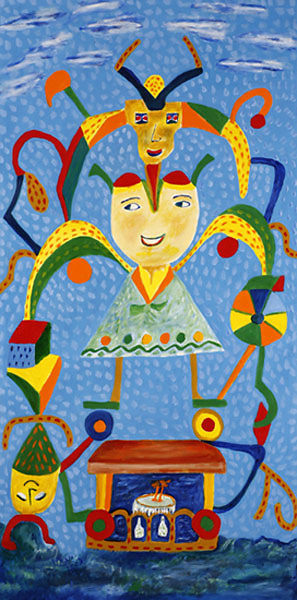
Chava Wolf: “Do you see the blow that I suffered? A fairly normal child with a pretty dress. I have wheels, as if our lives are rolling unsteadily. Instead of hands I have wings. Like I want to fly.”
Note to the Teacher:
In this painting we see Chava’s impression of the Jews imprisoned in the ghetto. The yellow, brown and tan snakelike boundary between the light blue and dark blue areas of the painting represent the barbed wire fence which surrounded the ghetto. Compare this to the way the common Holocaust motif of barbed wire fence is usually represented. Within the ghetto heavy rain is falling, while the light blue area outside remains clear. The four entangled figures within the boundaries of the ghetto represent imprisoned Jews, who are being guarded by the grinning yellow figure on the right. This guard has flowers sprouting from his body. Another menacing guard, standing on a chair outside of the ghetto, is either a Nazi soldier or a local collaborator. Note the symbols and themes of the rain in the ghetto, the lack of cohesive arms and legs, the yellow faces of the evil men.
Questions:
- What do we see in the picture?
- What is the yellow, brown and tan snake-like object? What is enclosed within the fence?
- In the enclosed area (the ghetto), what do their colors and expressions reveal about the figures representing Jews?
- Who is the yellow figure on the right? Why does he have flowers coming out of him? Who does the yellow figure on the left represent?
- What similar themes and symbols can you see in the previous pictures?
Note to the Teacher:
In this painting, some of the same themes and symbols emerge again. While in the ghetto, Chava saw wagons carrying frozen corpses - a memory that remains etched in her mind. The horse here is pulling such a wagon, while balancing precariously on balls or wheels. To the right we see a tent, representing the one Chava’s father tried to make in the woods to shelter his family. The outer flap of this tent bears a vision of warmly glowing Sabbath candles, representing Chava’s vanished childhood and warm, secure pre-war life. A figure, which may be a Nazi soldier, stands inside the tent, representing the enemy who forced Chava and family to leave their warm home behind. Menacing figures encircle the figure of a little girl, head bent, descending from the tent. On the bottom of this enclosure, we again see a river, with disembodied feet, symbolic of the Jewish victims afloat in the water. Presiding over all this is a menacing triangular figure, the “evil man” who symbolizes the oppressors. Rain again falls relentlessly in the background.
Questions:
- What do we see in the picture?
- What is the yellow, brown and tan snake-like object? What is enclosed within the fence?
- In the enclosed area (the ghetto), what do their colors and expressions reveal about the figures representing Jews?
- Who is the yellow figure on the right? Why does he have flowers coming out of him? Who does the yellow figure on the left represent?
- What similar themes and symbols can you see in the previous pictures?
Note to Teachers:
This is one of Chava’s most complex paintings. In its sections we see various scenes and symbols of her experiences and memories. In the middle we once again see the Sabbath table surrounded by two figures - possibly Chava’s parents. Hovering over this tranquil scene and threatening to destroy it, is another menacing yellow triangular figure, that of the “evil man”. On the upper left, we see a young girl crying in front of a burning house, the symbol of Chava’s own destroyed home and happy childhood, while a strange and threatening sun - one that offers no joy or warmth - looks on from the sky. In the white section to the right of this is a figure that Chava calls a devil, again representing the evil men. A smiling umbrella taunts, offering no protection to Chava and her family from the rain. Strange and frightening figures stand in the sections on the right part of the painting. In the middle of the bottom row, we see Chava on the ground in the forest – where she has been banished along with the Jews of the ghetto. She is suffering from typhus and is so ill with fever that she cannot see. She crawls around crying for her parents, from whom she has become separated. In the darkness – someone steps on her hand. In the green area above and to the left, we see a desperately thirsty Chava lying in bed, in a darkened room, sick with typhus. She has put a cup on the roof hoping that the figure on the right may take pity on her and offer her water. Her pleas, however, remain unanswered. The figures above this scene are a Nazi soldier and a Jewish child.
Questions:
- How does this painting differ from the previous ones?
- How is it similar to them?
- Now that you are familiar with Chava's symbolic world, what to you recognize in this picture?
Chava notes:
“In the year 2008, at the of age 76, I bought myself a doll. You may laugh, because why should a grown-up like me want a doll? Well I never had a doll when I was a child [in Transnistria]; I never had a childhood.”
Note to Teachers:
This painting is called, ”The birthday party I never had.” In the world of starvation, sickness, fear and poverty which Chava inhabited during the Holocaust, the struggle for survival did not allow for “trivialities” like birthday parties. When talking about the painting Chava highlights the happiness of this scene. She receives many presents. A happy sun shines in the sky and yet the rain is again in the background. Chava tells us that after the Holocaust it was always especially important for her to celebrate birthdays with her loved ones.
Questions:
- What do you see in this painting?
- Why do you think that Chava, as a child in Transnistria, never had a birthday party?
- Name some of the things you can do as children today, (go to school, have parties, eat ice-cream cakes, go wherever you want, etc.) Describe how you felt in anticiption and after these activities.
- Do you think children in the Holocaust enjoyed all of the childhood things that children enjoy today? If not, why not? What is the meaning of these "trivialities" in life?
- Looking at these pictures and the others, what would you say are some of the clearest memories of Chava’s childhood in the Holocaust? How do you think this experience affected her childhood?
Note to Teachers:
Chava said many times that what her parents gave her spiritually before, during and after the Holocaust helped her survive and keep on struggling even later in life. She continues to draw strength from these early, pleasant experiences.
After viewing and discussing these paintings, the students have been given a method for understanding their meanings. By first describing what they see and then searching for the symbols, colors and themes, they have gained insight into the personal visual language of Chava Wolf.
Part Two
The teacher can open this part of the lesson with a brief discussion of the different perspectives of creating Holocaust art – that of the Holocaust survivor (Chava) and that of the person who did not experience the Holocaust, but can still connect emotionally to the subject.
The goal is for the teacher to give students a perspective of their own legitimacy in making art about this subject.
Below is a selection of Chava’s poetry, as well as other poetry and quotes written by Jewish children describing their different experiences the Holocaust. This additional material is provided to widen students’ exposure to other children’s stories and to provide a springboard for finding their own personal images and references, beyond those they have already seen in Chava’s paintings. Teachers can begin by reading some of the poems and/or handing out copies for the students to refer to as they work.
Using the vivid descriptions and imagery in these selections as a starting point, the students will create their own artwork. Some students will choose to take a more literal or illustrative portrayal of the material, while others may concentrate more on their own feelings and perceptions. Some may use a more figurative approach, some more abstract or expressionistic. All are valid responses. Teachers may wish to review Chava’s poetry and other selected texts below focusing on the following themes:
- Life Before the War
- Hope
- Fear
- Longing
- Despair
- Loss of childhood
Teachers may wish to point out that:
- Chava covers her entire canvasses with color.
- Her canvas is sometimes divided into different scenes like in the big picture and sometimes a more centrally-placed composition (little girl with the being hit by the Nazi soldier)
- Chava uses symbols of many things (bad men, the umbrellas, etc) and that the students can also try and find their own symbols.
Students may use the following suggestions, but they do not need to be limited to these methods. However, they do allow for very colorful and rich results.
- The students can paint a background, perhaps using many colors, patterns or even patches of tissue paper. Onto this they can glue the main elements of the drawings – figures, images, even words if they so wish - which they will create and cut out from separate sheets of paper.
- The main elements can first be drawn onto the paper in oil pastels. A subsequent wash of watercolor over the pastels will add a surface of color over the entire paper while resisting the oil in the pastels - with interesting results.
- The children can use a different color than white for the base paper. Light blue, red and yellow can be used as the base paper, with the artwork painted on top with tempera.
When the artwork is complete, it is important that each student talk about what he has created, and his own use of color and symbols.
Supplementary Poems and Quotes for Part Two:
In the Other Childhood - Chava Wolf
Translated from Hebrew into English
In the other childhood
German fairy tales
About magical princesses and love stories
And on Saturday nights, after “Havdalah”
A Hassidic1 tale about the wonders
Of great rabbis
Always surrounded by love
I was eported to a void!
Our whole lives packed in bags
My mother’s hand caresses my head
My father’s glance gives comfort
No more tales of miracles and wonders,
That won’t happen here.
The princess now crawls in the snow,
Begging for some bread and water.
Her clothes are torn, her feet frozen;
A princess sick with typhus2 searches for a bed.
No more light in the castle,
The memory of stories extinguished
My Childhood Once Again - Chava Wolf
Translated from Hebrew to English
The glorious brightness of morning light
Penetrates through the window
Although my head is covered
The shadows chases every corner of the room
Terrified I run, the forest is once more in front of me
Cold and rain freezing within me The glorious light is no more
My childhood once again.
Tears – Chava Wolf
Translated from Hebrew to English
My eyes are tearing
A drop falls
Holding pain within
Bodies, bodies
Packed on carts
Appear before my eyes
A child looks on and cries
No compassion
Broken walls,
Boards, closets
The remains of our lives in piles
I am reaching my hands
Almost touching, tearing
As if shouting
From aside looks a mug-shaped head
His eyes compassionless
His horns also scary
A child looks and don’t understand
How her world was destroyed.
Extract from a diary, written by an anonymous girl, Lodz Ghetto, Poland3 March 7, 1942
“…today is a nice day. When the sun is shining, it’s easier on the soul. You miss another life. When you see the fence, separating us from the rest of the world, the soul longs for freedom, like a bird in a cage. The eyes are filled with tears. How I envy the birds. The heart bursts with longing. I remember the years gone by. Will I live in better times? Who knows? Will I ever be with my parents and my friends? Who knows? Will I eat lots of bread and wheat? In the meantime, hunger bites and there is nothing left to cook”.
A Dream
Abraham Kopolovitz4
When I grow up and reach the age of twenty
I will go out and see our lovely world.
I will sit inside a bird with an engine
Take off and rise up to the sky, high above
I will fly, sail above a distant and beautiful world
Pass by rivers and seas
To the sky I shall climb and soar
The cloud my sister, and the wind my brother.
The Butterfly Pavel Friedman June 4, 19425
The last, the very last,
So richly, brightly, dazzlingly yellow.
Perhaps if the sun's tears would sing
against a white stone...
Such, such a yellow
Is carried lightly 'way up high.
It went away I'm sure because it wished to
kiss the world good-bye.
For seven weeks I've lived in here,
Penned up inside this ghetto.
But I have found what I love here.
The dandelions call to me
And the white chestnut branches in the court.
Only I never saw another butterfly.
That butterfly was the last one.
Butterflies don't live in here,
in the ghetto.
Hannele Davidson (age 11), Germany6
"One of the most popular games which was played by the older children with great vigor was Volkerball, a type of hand-ball game with two teams and complicated rules. It was a great day when the older children allowed us to take part… Winter in Gerresheim was particularly a happy time.. I loved to watch the first snow falling; large grey flakes from behind the windowpane, settling soundlessly on branches, fences, and streetlamps. I loved the sense of warmth and safety it gave me… Snowball-fights raged up and down the street and even grownups sometimes became involved..."
Liliana Zucker (age 12), Poland7
“It was a beautiful August day and the sun started its journey to the west. I could see its reddish-yellow face peeking through the tall trees, slowly disappearing behind the horizon. Dusk in the small Polish village was enchanting. I love this time of year – it was vacation time, away from the city, away from the school.”
Kitty Hart-Moxon (age 13), Bielsko, Poland8
“I have been able to skate, ski, and swim ever since I was four years old, and so since early childhood my sole interest has been sports. I have been training hard for the forthcoming swimming championships.”
Charlotte Veresova (age 14), Czechoslovakia9
“I’ve learned here to appreciate ordinary things. Things that, if we had them when we were still free, we hadn’t noticed at all. Like riding a bus or train, or walking free along the road to the water, or to go buy ice cream. Such an ordinary thing, and it’s out of our reach.”
Susan Neulaender Faulkner (age 17), Germany10
“I was walking over the sidewalks with glass crunching under my feet. On the next street.. the oldest synagogue in Berlin was in flames. The entire sidewalk across from the synagogue was a carnival to the onlookers, applauding and laughing… flames lighting up in the sky… All I wanted was just to get out, get out.”
Sima Skurkowitz (age 17), Vilna, Lithuania11
“Flowers did not grow in the alleys of the ghetto. Hardly a single shaft of sunlight penetrated the damp and miserable ghetto walls. One day the Germans said it would do the ghetto children good to enjoy a little sunshine and fresh air. They arranged a nature outing for a group of children – to go ‘outside’ on a trip into the woods. The first group returned laughing and chatting happily after a blissful day. Parents, seeing the children’s happiness after so much suffering, allowed another group to go.. then another, and another. But the succeeding groups were never seen again.”
Susan Neulaender Faulkner (age 16), Germany12
“Once a week we had to go to the auditorium to listen to a propaganda speech over the radio, usually by Hitler, and we had to sit on the bench, totally separated from the rest of the girls, but we had to attend. There was no way for us to get out of it. And each time the speaker would say something against “the Jew”, the entire school would almost turn around and look at our faces to see our reactions..”
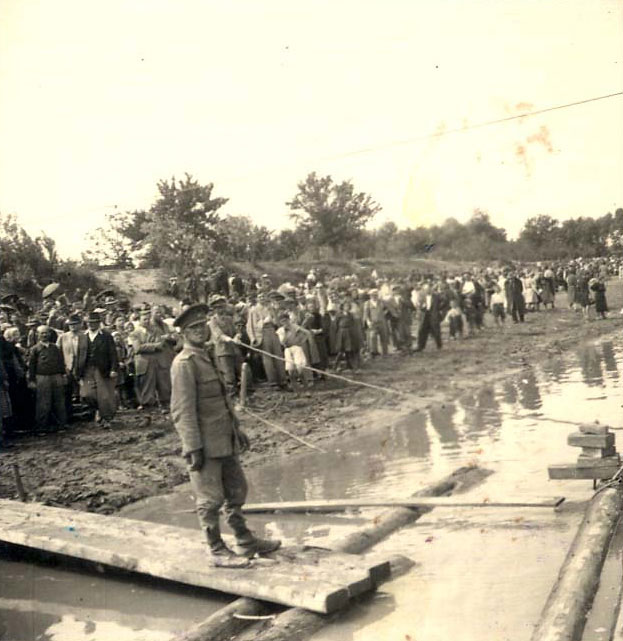
Moghilev Podolski, Ukraine, Jews waiting for a raft to transfer them to Transnistria during the deportation, June 10, 1942




